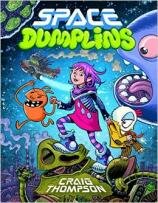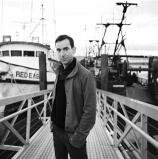Space Dumplins
Review
Space Dumplins
Craig Thompson’s massive 2003 autobiographical graphic novel BLANKETS is the kind of work that transcends its medium and finds its way into even the most hardened skeptics’ hearts. It belongs in that rare company---along with books like Chris Ware’s JIMMY CORRIGAN: The Smartest Kid on Earth, Marjane Satrapi’s PERSEPOLIS and Art Spiegelman’s MAUS---of comics for people who don’t read comics. At nearly seven-hundred pages, his 2011 work HABIBI is just as massive, but less loved. HABIBI received mixed reviews, with critics lavishing praise on the art while at the same time calling Thompson out for the book’s Orientalism.
So, where does Craig Thompson go next? Outer space, of course. In SPACE DUMPLINS we meet young Violet, a young girl living in a downtrodden area of the galaxy called the Roids with her fashion designer mother, Cera, and Gar, her lumberjack father. When Violet’s school is destroyed by monstrous space-dwelling whales, her parents scramble to find a new place for their daughter to get an education. This fight for better opportunities sets in motion a series of events which finds Violet befriending a neurotic chicken with prophetic visions, teaming up with a space biker gang to save her father from the belly of a whale, and fleeing her home to escape an unstoppable tide of whale diarrhea.
It’s an interesting approach, but this book has none of the emotion of BLANKETS or the narrative sweep of HABIBI.
Here, humans and aliens co-mingle with few obvious problems, but as in the real world, social class separates friends, blocks opportunity, and keeps the doors to the future closed. That makes SPACE DUMPLINS sound like a heavy read for its intended 8-12 year-old audience, but Thompson lightens the mood with space ships shaped like hamburgers and turtles and lobsters. Then there’s the feces. So committed is Thompson’s toilet humor that he makes whale dung the economic driver of the galaxy, a commodity produced by the same space whales who wreak havoc on the poor populations of the Roids.
It’s an interesting approach, but this book has none of the emotion of BLANKETS or the narrative sweep of HABIBI. It feels like an attempt at doing an old-fashioned space opera yarn, but it fails at being anything other than nice to look at. The sawmill where Gar works is an impressive feat of Jack Kirby-esque scifi architecture, the kind of spaceship-as-landscape which can draw a reader to the page and keep them there as they explore cooling towers, exhaust ports and pipelines.
Thompson also shows us a cutaway of Gar’s spaceship, a junker shaped like a tugboat, and another of one of the whales, which is both gross and wonderful. The book is filled with images that make you stop and linger---something all great comics do---but a great story makes you want to turn the page to see what happens next. Here, turning the page is a relief because it means we’re that much closer to the end.
It’s important that cartoonists focus on work for younger readers or, more importantly, readers of all ages. Think of what Pixar does with movies. The emotion and silliness in movies like Inside Out makes parents want to engage with the culture their kids are consuming. Unfortunately, SPACE DUMPLINS talks down to its readers with a saccharine message of family and sacrifice and even pretensions of spirituality. Though it’s unrelentingly silly, the world Thompson’s built here is the best part, a nonsense dystopia of food- and feces-obsessed refugees living in space. Spaceships shaped like food and animals, planet-sized masses of trash floating in space---this should be fun. Instead, it gets mired in flat characters and episodes of self-seriousness so out of place they read like they’re from a different book. If only they were.
Reviewed by Jeremy Estes on August 25, 2015
Space Dumplins
- Publication Date: August 25, 2015
- Genres: Graphic Novel
- : 320 pages
- Publisher: Graphix
- ISBN-10: 0545565413
- ISBN-13: 978-0545565417










